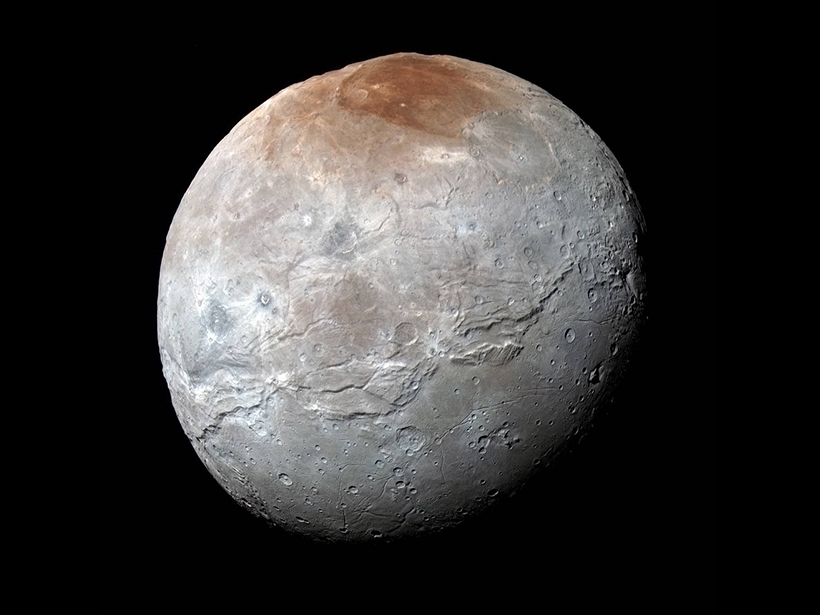As humanity started getting its first close views of Pluto and its moons last year, one thing became clear: The poles of the dwarf planet’s largest moon Charon were much darker than the rest of that moon. During its flyby, the New Horizons probe subsequently revealed that these dark spots contained a dusty-red material, and since then, scientists have been scratching their heads as to how the material got there.
Last year, New Horizons scientists speculated that Charon may be accumulating some of Pluto’s lost atmosphere—particularly methane—at its poles. In a paper published yesterday in Nature, the team has come up with a process by which methane (CH4) gets trapped during the poles’ long, cold winters, said lead author Will Grundy, a planetary scientist at the Lowell Observatory in Flagstaff, Ariz., and coinvestigator on NASA’s New Horizons mission. Grundy heads up the mission’s surface composition team.
Half the size of Pluto, Charon orbits about 20,000 kilometers away from the dwarf planet. That’s very close compared with our Moon, which lies more than 300,000 kilometers from Earth. Studying Charon’s red poles may help researchers better understand the interactions of bodies orbiting in proximity in other planetary systems, Grundy said. “Anytime you do exploration at some place that’s entirely new, you’ll see strange phenomena, and it sets off a race to figure out how it works,” he said.
Bouncing Methane
Several steps make up the process Grundy and his colleagues propose for the reddening of Charon’s poles. It starts with methane streaming away from Pluto, a body too small to hold on to a thick atmosphere, Grundy said.
The team estimates that 5 × 1025 molecules of methane stream off Pluto every second.
Using previous research, the team estimates that 5 × 1025 molecules of methane (that’s 5 with 25 zeros after it) stream off the dwarf planet every second. Previous calculations revealed that about 2.5% of this methane gets captured by Charon.
“Anything that’s streaming out near Charon is attracted to Charon,” Grundy said.
Charon’s rotation axis tips about 119°, which means it spins on its “side.” And because the moon is tidally locked with Pluto, for half of Pluto’s year (which is just over a century on Earth) each of the moon’s poles gets almost no direct sunlight, Grundy said. Temperatures plummet to the teens—in kelvins. For reference, 10 kelvins is about –200°C.
Like trillions of tiny Ping-Pong balls, methane molecules trapped by Charon’s gravity bounce around on the surface, sticking where it’s too cold to escape, Grundy continued. On the basis of how much methane escapes Pluto, the researchers suggest that methane at the poles accumulates 0.16 millimeter every 1 million Earth years.
Although polar ice caps have been seen on other planets, making a polar cap by trapping gas from another body seems to be a new phenomenon, Grundy added.
Sun-Driven Processing
Meanwhile, the occasional photon from the Sun, more than 5 billion kilometers away, strikes these methane molecules. The photons don’t always travel directly from the Sun, however—at Charon’s distance, many photons arrive after bouncing off of interplanetary hydrogen.
So even if Charon’s pole isn’t tilted toward the Sun, photons can still interact with the pole’s methane. Often, the photons have enough energy to break bonds in the molecules, which makes them highly reactive. This leads to formation of new organic molecules collectively called tholins.
Tholins, complex organic “gunk” not of biological origin, are likely the source of the red color of the poles, Grundy said. Tholin doesn’t form naturally on Earth, but it does show up on ice-covered bodies, like comets, and on Pluto itself.
During the long, cold winter, about 20% of the methane gets “processed” by cosmic rays or interplanetary photons, said Randy Gladstone, head of New Horizon’s atmospheric research team and coauthor on the new paper. Then, when either pole gets exposed to sunlight for a decades-long summer, any leftover methane sublimates away, leaving behind “a varnish on the pole, which can continue to darken over time to become a true tholin,” said Gladstone.
“We think the red layer is only on the order of 1 millimeter thick, which would take about 10 million years to accumulate.”
“We think the red layer is only on the order of 1 millimeter thick, which would take about 10 million years to accumulate, so the varnishing of Charon’s poles is a very slow process,” Gladstone continued.
However, Gladstone emphasized that these are very rough guesses, and Grundy also reiterated that more research is needed to understand the multistep process that reddens Charon’s poles.
Grundy hopes that one day scientists can use this knowledge to investigate whether similar processes occur on other dwarf planets, like Eris or Makemake, “but it’ll be a long time before we ever get to see resolved images of those bodies,” he said.
—JoAnna Wendel, Staff Writer
Citation:
Wendel, J. (2016), Scientists solve Charon’s red mystery, Eos, 97, https://doi.org/10.1029/2016EO059453. Published on 15 September 2016.
Text © 2016. The authors. CC BY-NC 3.0
Except where otherwise noted, images are subject to copyright. Any reuse without express permission from the copyright owner is prohibited.

